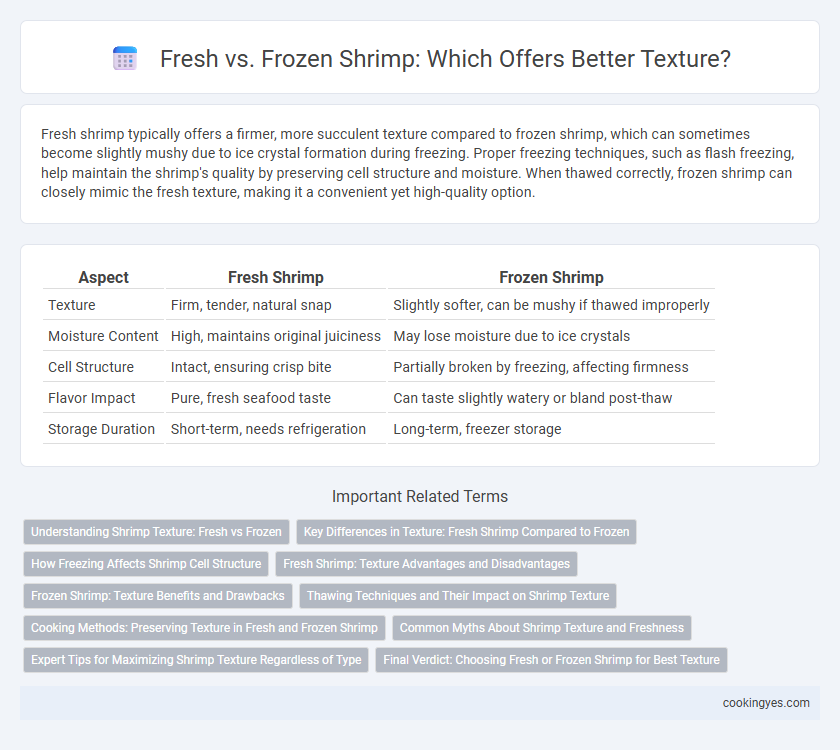Fresh shrimp typically offers a firmer, more succulent texture compared to frozen shrimp, which can sometimes become slightly mushy due to ice crystal formation during freezing. Proper freezing techniques, such as flash freezing, help maintain the shrimp's quality by preserving cell structure and moisture. When thawed correctly, frozen shrimp can closely mimic the fresh texture, making it a convenient yet high-quality option.
Table of Comparison
| Aspect | Fresh Shrimp | Frozen Shrimp |
|---|---|---|
| Texture | Firm, tender, natural snap | Slightly softer, can be mushy if thawed improperly |
| Moisture Content | High, maintains original juiciness | May lose moisture due to ice crystals |
| Cell Structure | Intact, ensuring crisp bite | Partially broken by freezing, affecting firmness |
| Flavor Impact | Pure, fresh seafood taste | Can taste slightly watery or bland post-thaw |
| Storage Duration | Short-term, needs refrigeration | Long-term, freezer storage |
Understanding Shrimp Texture: Fresh vs Frozen
Shrimp texture varies significantly between fresh and frozen forms due to cellular water content and ice crystal formation during freezing. Fresh shrimp typically offers a firmer, more succulent bite because the muscle fibers remain intact without the damage caused by freezing. Frozen shrimp may experience slight texture softening or toughness as ice crystals can rupture cells, leading to water loss when thawed, impacting overall mouthfeel.
Key Differences in Texture: Fresh Shrimp Compared to Frozen
Fresh shrimp offer a firm, succulent texture with a natural snap that tends to be more delicate than frozen counterparts. Frozen shrimp may have a slightly softer texture caused by ice crystal formation during freezing, which can disrupt muscle fibers. Proper thawing techniques can minimize these textural differences, preserving the shrimp's quality and bite.
How Freezing Affects Shrimp Cell Structure
Freezing shrimp causes the formation of ice crystals within their cell structure, which can rupture cell walls and lead to a loss of firmness once thawed. This cellular damage often results in a softer texture compared to fresh shrimp, which retains its natural snap and juiciness. Proper freezing techniques, including rapid freezing and maintaining consistent low temperatures, help minimize ice crystal size and preserve shrimp texture more effectively.
Fresh Shrimp: Texture Advantages and Disadvantages
Fresh shrimp offers a firm, succulent texture prized for its natural sweetness and tender bite, making it ideal for raw or lightly cooked dishes. However, its texture can quickly deteriorate due to rapid spoilage if not consumed immediately, leading to a mushy or slimy consistency. The limited shelf life of fresh shrimp demands prompt consumption, impacting convenience and availability compared to frozen alternatives.
Frozen Shrimp: Texture Benefits and Drawbacks
Frozen shrimp preserve texture by locking in moisture immediately after harvesting, minimizing enzymatic breakdown and bacterial growth that can degrade firmness. However, ice crystal formation during freezing may cause cell wall rupture, leading to a slightly softer or mushier texture upon thawing. Proper rapid freezing and controlled thawing methods help maintain optimal shrimp texture, balancing convenience and quality.
Thawing Techniques and Their Impact on Shrimp Texture
Proper thawing techniques significantly influence shrimp texture, with slow thawing in the refrigerator preserving firmness and minimizing moisture loss. Rapid thawing methods, such as microwaving or warm water baths, often result in a mushy texture due to uneven ice crystal melting and protein breakdown. Maintaining consistent, gradual thawing ensures shrimp retain their natural snap and succulent bite, crucial for culinary quality.
Cooking Methods: Preserving Texture in Fresh and Frozen Shrimp
Cooking methods significantly impact the texture of fresh and frozen shrimp, with steaming and quick sauteing best preserving the firm, succulent quality of fresh shrimp. For frozen shrimp, gradual thawing in the refrigerator maintains moisture and prevents the rubbery texture often caused by rapid temperature changes. Avoiding overcooking is crucial in both forms to retain the shrimp's natural tenderness and avoid toughness.
Common Myths About Shrimp Texture and Freshness
Common myths suggest fresh shrimp always have superior texture compared to frozen shrimp, but modern freezing techniques like flash freezing at -40degF (-40degC) preserve texture effectively. Studies show that properly frozen shrimp maintain firmness and moisture levels, preventing the mushy texture often attributed to thawed shrimp. Quality depends more on handling and storage conditions than the fresh versus frozen status alone.
Expert Tips for Maximizing Shrimp Texture Regardless of Type
Expert tips for maximizing shrimp texture include quickly thawing frozen shrimp under cold running water to preserve firmness and avoiding overcooking, which leads to rubberiness in both fresh and frozen shrimp. Using a brine of salt and sugar for 15-30 minutes enhances moisture retention and improves texture consistency. Properly peeling and deveining shrimp before cooking ensures even heat distribution and optimal bite quality.
Final Verdict: Choosing Fresh or Frozen Shrimp for Best Texture
Fresh shrimp typically deliver a firmer, more delicate texture because they retain natural moisture better, which enhances the eating experience. Frozen shrimp, if properly thawed, can maintain comparable texture while offering convenience and extended shelf life without significant quality loss. For the best texture, select fresh shrimp when available, but high-quality frozen shrimp prepared correctly remains a reliable alternative.
Fresh vs frozen for shrimp texture Infographic

 cookingyes.com
cookingyes.com